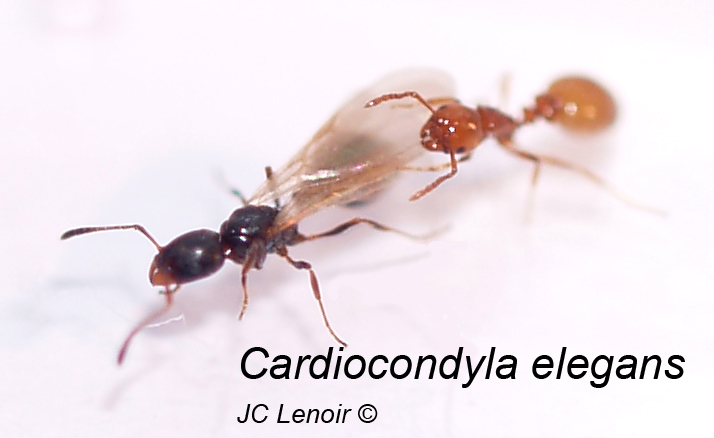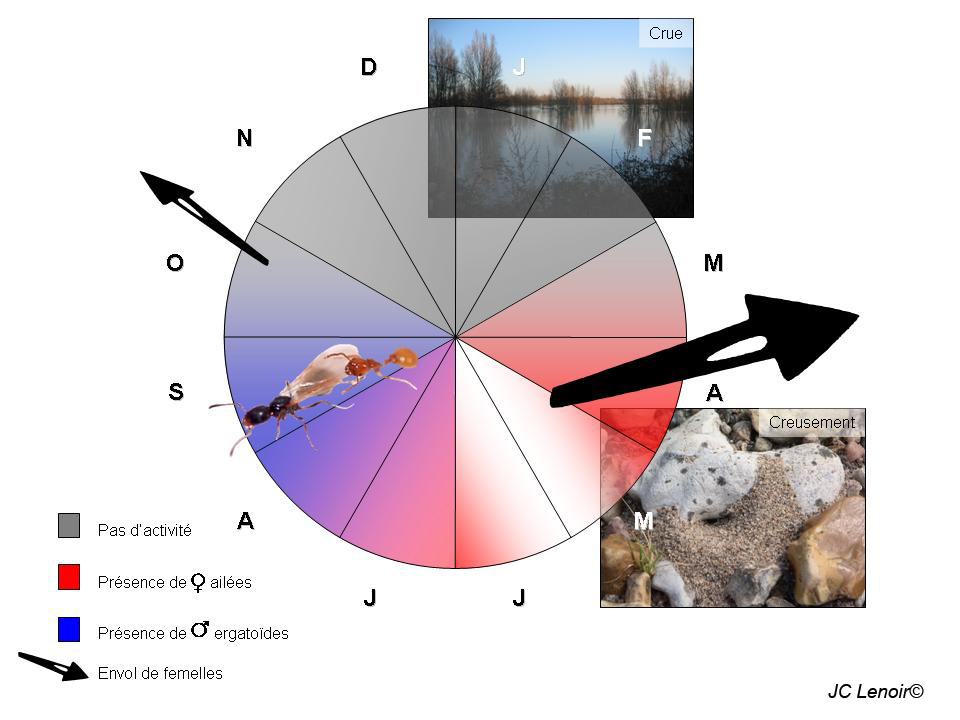Ph.D. Thesis
| thesis manuscript [download in pdf format, 2,7 Mo] |
Ph.D. thesis in Life Sciences at the University of Tours, under the direction of Alain Lenoir and Jean-Luc  Mercier (IRBI) : "Social structure and reproductive strategies of Cardiocondyla elegans".
Mercier (IRBI) : "Social structure and reproductive strategies of Cardiocondyla elegans".
Defended in June 22, 2006
Jury:
Summary:
Cardiocondyla elegans is a Mediterranean ant that is present in the Loire River sides. The aims of this thesis were to have a better understanding of its biology, reproductive strategies as well as the characteristics of its environment. We then used an integrated framework: pedology, ecology and botanic for the habitat and environment characterization, genetic and ethology to determine the genetic structure of nests and populations and to investigate behaviour of sexual individuals.
 C. elegans nests consist of a 40 cm deep vertical pipe connecting a dozen of chambers. In Loire River habitats, C. elegans was found only in stable alluvial deposits. The composition of these sediments are from importance for the survival of the nests. They provide constant temperature in the deepest chambers; even in the hottest period of the summer, temperature remains less than 30°C with few daily variations. As the sediments containing less than 60% fine sand, the habitat can resist to foods and these rises in the watertable can retain an air pocket needed for ants to survive.
C. elegans nests consist of a 40 cm deep vertical pipe connecting a dozen of chambers. In Loire River habitats, C. elegans was found only in stable alluvial deposits. The composition of these sediments are from importance for the survival of the nests. They provide constant temperature in the deepest chambers; even in the hottest period of the summer, temperature remains less than 30°C with few daily variations. As the sediments containing less than 60% fine sand, the habitat can resist to foods and these rises in the watertable can retain an air pocket needed for ants to survive.
Our study on spatial distribution of colonies along two successive years reveals that 40% of them disappear because of the winter conditions. Nonetheless, numerous winged females survive and found new nests. C. elegans generally attains a density of 1 nest per m2 in Loire riverine habitat during the summer. As this ant lives in a patchy environment, colonies compete for space, and we found that they finally distribute regularly. Intra-specific competition is probably one of the reasons why less than 1% of the new queen success in nest foundation.
From July to September, mature nests produce sexual individuals. C. elegans develop regular winged female and more peculiar wingless ergatoid males. Contrary to other ergatoid males in Cardiocondyla genus, males of C. elegans are mutually tolerant. We confirmed monogyny for this species with one queen and about 200 workers per nest. The mean numbers of ergatoid males and winged females during the reproductive period are respectively 5.3 and 76.6. Usually, the mother queen was mated by several males. Individuals of the same nest came from about 4.5 different patrilines.
 Analysis of the population genetic structure indicates that 30% of the copulations involve unrelated partners. We also founded numerous alien sexuals inside the nests. Foreign sexuals inside nests of a monogynous ant species is puzzling and ask questions on the reproductive strategies of C. elegans. In behavioural tests of adoption, host workers always accept ergatoid males to enter their nest whereas they repel and attack winged females. The presence of alien winged females inside nests can be explained by the active carrying behaviour of some workers in the field. These workers carry winged females from a nest to another one and host workers do not develop aggressive behaviour in these conditions. Exchanges of sexual individuals can reduce inbreeding depression in the population and then avoid diploid males’ problems. That also provides more genetic variability to resist in case of major environmental changes.
Analysis of the population genetic structure indicates that 30% of the copulations involve unrelated partners. We also founded numerous alien sexuals inside the nests. Foreign sexuals inside nests of a monogynous ant species is puzzling and ask questions on the reproductive strategies of C. elegans. In behavioural tests of adoption, host workers always accept ergatoid males to enter their nest whereas they repel and attack winged females. The presence of alien winged females inside nests can be explained by the active carrying behaviour of some workers in the field. These workers carry winged females from a nest to another one and host workers do not develop aggressive behaviour in these conditions. Exchanges of sexual individuals can reduce inbreeding depression in the population and then avoid diploid males’ problems. That also provides more genetic variability to resist in case of major environmental changes.
Then, our study show an original reproductive strategy for C. elegans, describes here for the first time. We also show that C. elegans is the only ant species adapted to early stages of stabilization of the alluvial deposits. Thus, along with the local flora, C. elegans can be used as an indicator to characterize the morphological evolution of the secondary channels of the Loire River.
Keywords: ants; Cardiocondyla; Loire River; flood; pioneer species; bio-indicator; spatial distribution; reproductive strategy; ergatoid males; intranidal multiple matings; sexual individuals adoption.
Update: 27/11/06